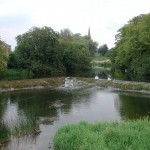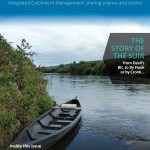'Hydrometrics’ is the measurement of water levels and flow -…
Time to rewild? – a view from across the Irish Sea
Alastair Driver, Director of Rewilding Britain, gives his views on the potential for rewilding in the UK, including natural water retention measures that have multiple benefits for water quality, biodiversity and reducing flooding risk.
UK politics used to be so boring. For me it was somewhere between shopping for clothes and watching paint dry. Not anymore. Now, thanks to the radical Brexit decision, we at least have a once-in-a-lifetime opportunity to change the most important set of rules affecting the natural environment in the UK – namely how we fund the management of our rural land and for what purposes. This is where “rewilding” has a key role to play.
We now have steadily growing evidence that localized restoration interventions deliver significant measurable benefits at a small-medium scale for flood risk management, water quality and biodiversity, etc, but I can still hear the sceptics saying “yes but there’s no evidence all this stuff works at scale”.
Well I for one am certain that it is largely case of multiplying up interventions across a larger area and joining them up – i.e. doing lots of small-medium sized things, a thousand times over. This is why rewilding now needs to be a key part of the rural debate, because it takes catchment restoration to another level, both in terms of scale and the extent of re-naturalisation.
My own working definition of rewilding, shamelessly constructed to fit in a tweet, is “The large-scale restoration of naturally functioning ecosystems towards the point where nature can flourish unmanaged for the benefit of people and wildlife”.
However, rewilding is a process and various elements of that process apply across a wide spectrum of activity, with scale and impact generally increasing as you move along that spectrum, and everyone having a role to play. I am currently toying with the idea of promoting a grading system for rewilding, with my pocket handkerchief garden wildlife pond being at the bottom end of the spectrum at say Grade 4, and Grade 1 being the Holy Grail where it basically means “hands-off” across a very large area. In scale terms, now at least, this probably means blocks of 10,000 ha plus in England, Wales and Northern Ireland and 100,000 ha plus in Scotland. Rewilding of this scale should also involve the reintroduction of keystone species such as Beavers, Pine Martens, Lynx and Wild Boar, where necessary, to help achieve and sustain the naturally functioning ecosystems, and yes at the largest end of the scale it could even ultimately mean, in really extensive remote parts of Scotland, Wolves and Elk – but certainly not in my lifetime!
Making the journey with local landowners and communities on board
Right now, however, we have a long way to go before we have anywhere in the UK of that Grade 1 standard, so we should focus hard on the journey, not the destination, and we must make that journey with local landowners and communities on board. We cannot and should not attempt it without their support, for many obvious reasons which I don’t have the space to summarise here, but which most EPA Catchment Newsletter readers will be all too aware of.
It’s not for me to go preaching abroad when we haven’t got our own act together in the UK, but if asked, my advice would be – don’t wait for the UK to adopt this approach – get on and do what you can now. The environment is a long way down the Brexit pecking order and although we are hearing the right noises from the Secretary of State, Michael Gove, we are still some way from adopting a Payment for Ecosystem Services-based land management system.
I would urge colleagues in Ireland to take every opportunity to prompt, enthuse, nag and inspire the delivery of multiple benefits through every organisation, project, plan and strategy you deal with, whether you are drafting the next round of agri-environment funding rules or designing a stream diversion for a road bypass. If we all do this, we will build a societal land management culture where joined-up thinking becomes the norm, moving our governments towards valuing rural land for the full range of societal benefits that it can provide, and not just for “food and birds”. This will in turn lead to the acceptance that in some parts of the country, true “rewilding” genuinely is the best socio-economic option for local communities which will then help to keep them in remote rural areas.
Our time is now, but we need to act fast.
Alastair Driver, Director, Rewilding Britain
Twitter: @AliDriverUK
http://www.rewildingbritain.org.uk/
You can see a presentation Alastair recently gave to the EPA’s Catchment Management Course here: https://www.slideshare. net/EPAIreland/alastair-drivers-drivers-for-better-catchment-management
You can read some evidence recently published by the UK Environment Agency on Natural Flood Management here: https:// www.gov.uk/government/news/natural-flood-management-part-of-the-nations-flood-resilience







